E_{i j}, E_{j i} and H_{i j} equals E_{i j} bracket E_{j i} span a subalgebra of little s l 3 C isomorphic to little s l 2 C.
The Weyl group of SU(3)
Review
Last time, we introduced special names for some of the weights of an SU(3)-representation: we set L_1 of theta to be theta_1, L_2 of theta to be theta_2, L_3 of theta to be theta_3, which is minus theta_1 minus theta_2. The roots (weight of the adjoint representation) are then L_i - L_j, with the root space spanned by E_{ij}\in W_{L_i-L_j}. We discussed how the root vectors E_{i j} in little s l 3 C act on the weight spaces of a complex SU(3)-representation: E_{i j} sends weight vectors with weight lambda to weight vectors with weight lambda plus L_i minus L_j. This is all illustrated in the following figures.
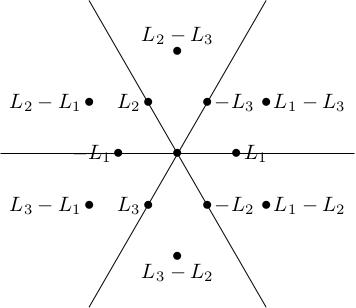
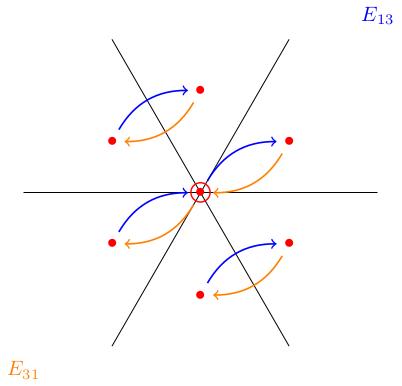
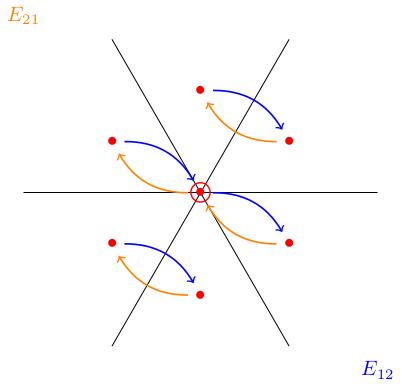
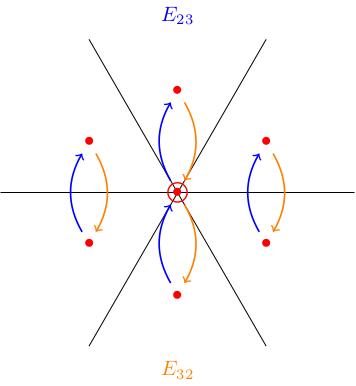
The matrices are simply obtained from X, Y, H by adding a row and column of zeros in position k where i, j, k is a permutation of 1, 2, 3. For example, E_{1 2} equals 0, 1, 0; 0, 0, 0; 0, 0, 0; E_{2 1} equals 0, 0, 0; 1, 0, 0; 0, 0, 0; and H_{1 2} equals 1, 0, 0; 0, minus 1, 0; 0, 0, 0. and you get X, Y, H by deleting row and column 3 from these three matrices.
This tells us that E_{i j}, E_{j i} and H_{i j} satisfy the commutation relations of X, Y, H in little s l 2 C, which is true because the extra column/row of zeros doesn't affect the calculation.
This gives us three little s l 2 C-subalgebras in little s l 3 C. Because of this, any little s l 3 C representation V splits as an little s l 2 C-representation in three ways.
I'll explain how this works in the example of the adjoint representation. With respect to the subalgebra spanned by E_{1 3}, E_{3 1}, H_{1 3}, we see that the weight spaces of the adjoint representation of little s l 3 C fall into three subsets which lie along lines parallel to L_1 minus L_3:
-
the points L_2 minus L_1 and L_2 minus L_3 at the top left of the figure;
-
the points L_1 minus L_2 and L_3 minus L_2 at the bottom right of the figure;
-
the points L_1 minus L_3, 0 and L_3 minus L_1 across the middle.
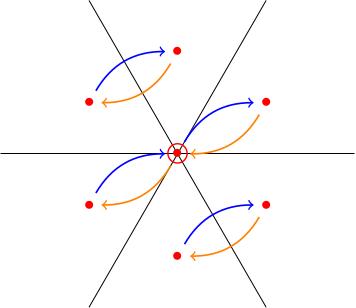
Because the arrows show the action of the little s l 2 C-subalgebra spanned by E_{1 3}, E_{3 1}, H_{1 3}, we see that the direct sums of these weight spaces form subrepresentations W_{L_2 minus L_1} direct sum W_{L_2 minus L_3}; W_{L_1 minus L_2} direct sum W_{L_3 minus L_3}; and W_{L_1 minus L_3} direct sum W_0 direct sum W_{L_3 minus L_1} Moreover, we can read off the weights of the little s l 2 C-subalgebra:
-
W_{L_2 minus L_1} direct sum W_{L_2 minus L_3} has the weight diagram of the standard representation,
-
W_{L_1 minus L_2} direct sum W_{L_3 minus L_2} also has the weight diagram of the standard representation,
-
W_{L_1 minus L_3} direct sum W_0 direct sum W_{L_3 minus L_1} has the weight diagram of Sym 2 C 2 direct sum the trivial one-dimensional representation because W_0 is 2-dimensional.
We would get a similar picture for the action of the subalgebra spanned by E_{1 2}, E_{2 1}, H_{1 2}:
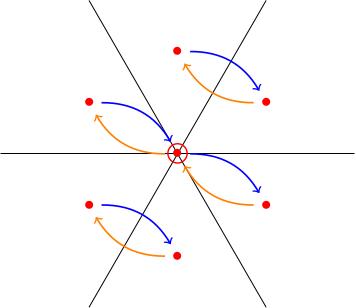
Weyl symmetry
Recall that little s l 2 C weight diagrams are symmetric about the origin. This means that for each of our three little s l 2 C-subalgebras, our weight diagram has a reflection symmetry in the line orthogonal to the corresponding root.
The weight diagram of any SU(3)-representation has three lines of reflection symmetry as shown in the figure below.
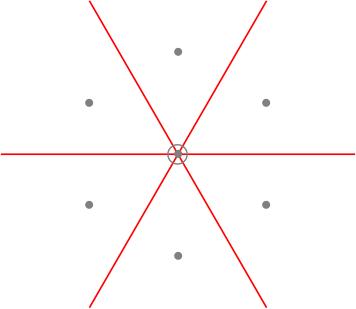
This reflection symmetry is an honest Euclidean symmetry because we have drawn our weight diagram on a triangular lattice. We will discuss this more when we talk about the Killing form.
The group of symmetries generated by these three reflection is called the
Consider the standard representation C 3. We saw that the weight diagram is the equilateral triangle with vertices at L_1, L_2, L_3. The three lines of reflective Weyl symmetry are precisely the lines of symmetry of this equilateral triangle.
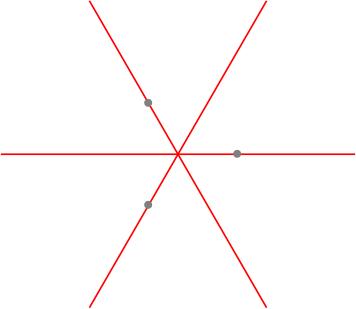
We can see from this that the Weyl group is isomorphic to the symmetry group of an equilateral triangle. It has size 6 (three reflections, three rotations including the identity). If lambda is a weight which occurs in the weight decomposition of a representation then sigma of lambda also occurs for any sigma in the Weyl group. Thus each weight occurs in an orbit of the Weyl group: by the orbit-stabiliser theorem, this will have size 6 (if the weight doesn't lie on any of the lines of reflection) or size 3 (if the weight is stabilised by one of the reflections) which is why our weight diagrams will be hexagons and triangles.
Pre-class exercise
How does \mathrm{Sym}^3(\CC^3) decompose into irreps of the \mathfrak{sl}(2,\CC)-subalgebra spanned by E_{1 2}, E_{2 1} and H_{1 2}?